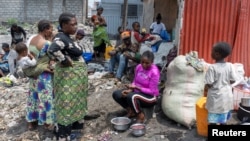Once crowded with white makeshift huts, the huge Kanyaruchinya camp for displaced people on the outskirts of Goma, in the war-torn Democratic Republic of Congo, looked eerily empty Sunday.
Since Goma was taken by M23 fighters earlier this week, some 100,000 internally displaced people have left the jam-packed hillside where they had set up several years ago.
The ongoing crisis in the eastern DRC continues to escalate, with tensions involving the Congolese government, and the M23 rebel group. The DRC government has officially designated the M23 rebel group as a terrorist organization, while the U.N. and the U.S. classify it as an armed rebel group.
The DRC government has repeatedly accused Rwanda of supporting the M23 rebel group, a claim that Rwanda denies. Kigali, in turn, alleges that Kinshasa collaborates with the Democratic Forces for the Liberation of Rwanda (FDLR), a Hutu armed group with ties to the perpetrators of the 1994 Rwandan genocide, an allegation the DRC rejects.
Military operations in the region remain fluid, with clashes leading to significant displacement and humanitarian concerns.
The M23 offensive in the mineral-rich eastern DRC is the latest to scar a region that has seen relentless conflict involving dozens of armed groups kill an estimated 6 million people over three decades.
"Life in the camp is a life of suffering and hunger," said Christine Bwiza, one of the last people to leave camp Kanyaruchinya, which sits near the Rwandan border.
There, residents had cobbled together makeshift huts from sticks and tarpaulin. Hunger was rampant and poor hygiene regularly caused cholera outbreaks.
Many had mixed feelings about finally going home.
Some said they were relieved, others stressed they had no choice. All worried about their future.
On the side of the road, a convoy of overcrowded trucks picked up some of the last contingents of travelers.
"I was a displaced person who came with nothing. And today I'm going home just as I came," said Denise Zaninga, seated at the back of a vehicle, adding that she had no idea where she was headed.
"I am leaving but I don't know where I'm going to live," she said.
Others shared her anxiety.
"Our homes are destroyed, our children are lost because of the war, and we are returning home hungry," said Bwiza.
For Aline Irafasha, "hunger will kill us wherever we go, but it's better to suffer at home."
The driver of the truck they had boarded said the M23 had paid for the vehicle and financed the trip.
Since M23 fighters and Rwandan troops have taken control of the city, the nearby front line has disappeared.
Surrounding territories are now accessible by road, bordered by abandoned military posts and charred armored vehicles.
Under pressure
The M23 has vowed to send displaced people back to where they came from, and their violent takeover of Goma meant people in the camp had little choice but to leave.
The overall population in Goma, a city of 1 million people, has nearly doubled in the past 30 years, swollen by victims fleeing violence.
At the camp, now a deserted, littered field, some said they had been pressured into leaving, but most preferred to go home before being forced to.
This sudden exodus sits well with locals whose farmlands were invaded and occupied for years.
"Here we used to have fields," said Elizabeth Base Sembimbi, pointing to a plot of land in ruins in front of her plank house.
"But we had to stop harvesting because of the robberies," she said, adding that she was looking forward to farming again.
On the side of the road, armed men, apparently from the Rwandan army, patrolled the street on foot.
One resident said that at nightfall, armed men had broken into people's homes looking for weapons and forcing young people to carry food and water over long distances without paying them.
"People are starting to feel scared," he said. "We can't say anything, we keep our mouths shut and observe."









